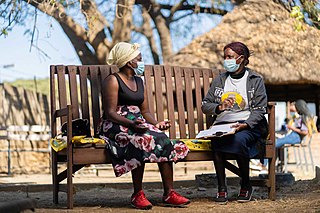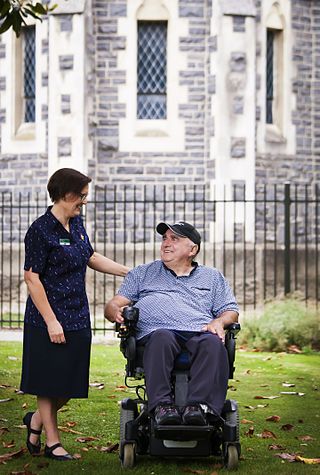
Cognitive behavioral therapy (CBT) is a psycho-social intervention that aims to reduce symptoms of various mental health conditions, primarily depression and anxiety disorders. Cognitive behavioral therapy is one of the most effective means of treatment for substance abuse and co-occurring mental health disorders. CBT focuses on challenging and changing cognitive distortions and their associated behaviors to improve emotional regulation and develop personal coping strategies that target solving current problems. Though it was originally designed to treat depression, its uses have been expanded to include many issues and the treatment of many mental health conditions, including anxiety, substance use disorders, marital problems, ADHD, and eating disorders. CBT includes a number of cognitive or behavioral psychotherapies that treat defined psychopathologies using evidence-based techniques and strategies.
Occupational therapists (OTs) are health care professionals specializing in occupational therapy and occupational science. OTs and occupational therapy assistants (OTAs) use scientific bases and a holistic perspective to promote a person's ability to fulfill their daily routines and roles. OTs have training in the physical, psychological, and social aspects of human functioning deriving from an education grounded in anatomical and physiological concepts, and psychological perspectives. They enable individuals across the lifespan by optimizing their abilities to perform activities that are meaningful to them ("occupations"). Human occupations include activities of daily living, work/vocation, play, education, leisure, rest and sleep, and social participation.
The Beck Depression Inventory, created by Aaron T. Beck, is a 21-question multiple-choice self-report inventory, one of the most widely used psychometric tests for measuring the severity of depression. Its development marked a shift among mental health professionals, who had until then, viewed depression from a psychodynamic perspective, instead of it being rooted in the patient's own thoughts.
A self-report inventory is a type of psychological test in which a person fills out a survey or questionnaire with or without the help of an investigator. Self-report inventories often ask direct questions about personal interests, values, symptoms, behaviors, and traits or personality types. Inventories are different from tests in that there is no objectively correct answer; responses are based on opinions and subjective perceptions. Most self-report inventories are brief and can be taken or administered within five to 15 minutes, although some, such as the Minnesota Multiphasic Personality Inventory (MMPI), can take several hours to fully complete. They are popular because they can be inexpensive to give and to score, and their scores can often show good reliability.
A patient-reported outcome (PRO) is a health outcome directly reported by the patient who experienced it. It stands in contrast to an outcome reported by someone else, such as a physician-reported outcome, a nurse-reported outcome, and so on. PRO methods, such as questionnaires, are used in clinical trials or other clinical settings, to help better understand a treatment's efficacy or effectiveness. The use of digitized PROs, or electronic patient-reported outcomes (ePROs), is on the rise in today's health research setting.

The Friendship Bench programme is a Zimbabwean community-based mental health intervention where trained community health workers sit on wooden park "Friendship Benches" set up at primary health care clinics or safe community spaces and provide structured problem-solving talk therapy to community members who come looking for mental health support or are referred by nurses or other community members.

A caregiver, carer or support worker is a paid or unpaid person who helps an individual with activities of daily living. Caregivers who are members of a care recipient's family or social network, and who may have no specific professional training, are often described as informal caregivers. Caregivers most commonly assist with impairments related to old age, disability, a disease, or a mental disorder.
The CAGE questionnaire, the name of which is an acronym of its four questions, is a widely used screening test for problem drinking and potential alcohol problems. The questionnaire takes less than one minute to administer, and is often used in primary care or other general settings as a quick screening tool rather than as an in-depth interview for those who have alcoholism. The CAGE questionnaire does not have a specific intended population, and is meant to find those who drink excessively and need treatment. The CAGE questionnaire is reliable and valid; however, it is not valid for diagnosis of other substance use disorders, although somewhat modified versions of the CAGE questionnaire have been frequently implemented for such a purpose.
Immersion therapy is a psychological technique which allows a patient to overcome fears (phobias), but can be used for anxiety and panic disorders.
A depression rating scale is a psychometric instrument (tool), usually a questionnaire whose wording has been validated with experimental evidence, having descriptive words and phrases that indicate the severity of depression for a time period. When used, an observer may make judgements and rate a person at a specified scale level with respect to identified characteristics. Rather than being used to diagnose depression, a depression rating scale may be used to assign a score to a person's behaviour where that score may be used to determine whether that person should be evaluated more thoroughly for a depressive disorder diagnosis. Several rating scales are used for this purpose.

In general, quality of life is the perceived quality of an individual's daily life, that is, an assessment of their well-being or lack thereof. This includes all emotional, social and physical aspects of the individual's life. In health care, health-related quality of life (HRQoL) is an assessment of how the individual's well-being may be affected over time by a disease, disability or disorder.
Improving Access to Psychological Therapies (IAPT), also known as NHS Talking Therapies, for anxiety and depression, is a National Health Service initiative to provide more psychotherapy to the general population in England. It was developed and introduced by the Labour Party as a result of economic evaluations by Professor Lord Richard Layard, based on new therapy guidelines from the National Institute for Health and Care Excellence as promoted by clinical psychologist David M. Clark.
Behavioral health outcome management (BHOM) involves the use of behavioral health outcome measurement data to help guide and inform the treatment of each individual patient. Like blood pressure, cholesterol and other routine lab work that helps to guide and inform general medical practice, the use of routine measurement in behavioral health is proving to be invaluable in assisting therapists to deliver better quality care.
The Youth Outcome Questionnaire is a collection of questions designed to collect data regarding the effectiveness of youth therapies. The Y-OQ is a parent report measure of treatment progress for children and adolescents receiving mental health interventions. The Y-OQ–SR is an adolescent self report measure appropriate for ages 12–18.
The Health Dynamics Inventory (HDI) is a 50 item self-report questionnaire developed to evaluate mental health functioning and change over time and treatment. The HDI was written to evaluate the three aspects of mental disorders as described in the Diagnostic and Statistical Manual of Mental Disorders (DSM): "clinically significant behavioral or psychological syndrome or pattern...associated with present distress...or disability". This also corresponds to the phase model described by Howard and colleagues Accordingly, the HDI assesses (1) the experience of emotional or behavioral symptoms that define mental illness, such as dysphoria, worry, angry outbursts, low self-esteem, or excessive drinking, (2) the level of emotional distress related to these symptoms, and (3) the impairment or problems fulfilling the major roles of one's life.
The primary care behavioral health (PCBH) consultation model is a psychological approach to population-based clinical health care that is simultaneously co-located, collaborative, and integrated within the primary care clinic. The goal of PCBH is to improve and promote overall health within the general population. This approach is important because approximately half of all patients in primary care present with psychiatric comorbidities, and 60% of psychiatric illness is treated in primary care.
The Patient-Reported Outcomes Measurement Information System (PROMIS) provides clinicians and researchers access to reliable, valid, and flexible measures of health status that assess physical, mental, and social well–being from the patient perspective. PROMIS measures are standardized, allowing for assessment of many patient-reported outcome domains—including pain, fatigue, emotional distress, physical functioning and social role participation—based on common metrics that allow for comparisons across domains, across chronic diseases, and with the general population. Further, PROMIS tools allow for computer adaptive testing, efficiently achieving precise measurement of health status domains with few items. There are PROMIS measures for both adults and children. PROMIS was established in 2004 with funding from the National Institutes of Health (NIH) as one of the initiatives of the NIH Roadmap for Medical Research.
Christopher James Alfred Granville Fairburn is a British psychiatrist and researcher. He is Emeritus Professor of Psychiatry at the University of Oxford. He is known for his research on the development, evaluation and dissemination of psychological treatments, especially for eating disorders.
The nine-item Patient Health Questionnaire (PHQ-9) is a depressive symptom scale and diagnostic tool introduced in 2001 to screen adult patients in primary care settings. The instrument assesses for the presence and severity of depressive symptoms and a possible depressive disorder. The PHQ-9 is a component of the larger self-administered Patient Health Questionnaire (PHQ), but can be used as a stand-alone instrument. The PHQ is part of Pfizer's larger suite of trademarked products, called the Primary Care Evaluation of Mental Disorders (PRIME-MD). The PHQ-9 takes less than three minutes to complete. It is scored by simply adding up the individual items' scores. Each of the nine items reflects a DSM-5 symptom of depression. Primary care providers can use the PHQ-9 to screen for possible depression in patients.




